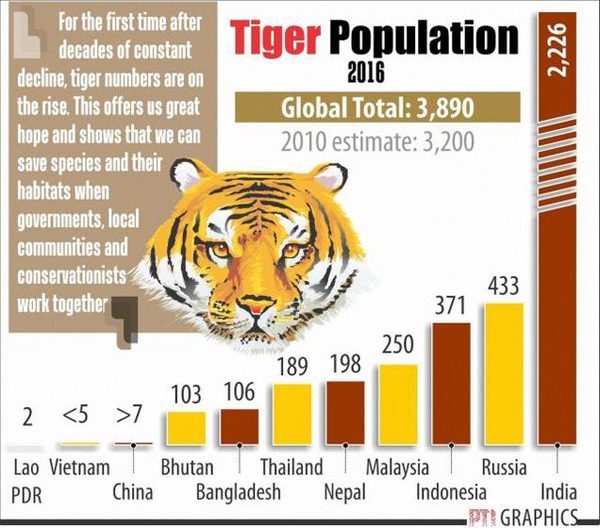
Photo by metalmaus
Reported Tiger Population Numbers
The World Wildlife Fund and the Global Tiger Forum recently reported a worldwide increase in tiger population. While this news brought cheers, there are disputes over the tiger population estimates and conservationists responded with a word of caution.
The Hindu reported that Ulas Karanth, Director for Science-Asia Wildlife Conservation Society, told them that while the tiger population has increased in India over the past 40 years, the same cannot be said of other countries. Karanth questions the authenticity of the World Wildlife Fund and Global Tiger Forum report, saying it was not based on estimates from intensive rigorous camera trap/DNA studios of source populations. Karanth said ” They are predominantly based on various kinds of counts of tiger spoor or in some cases simple guesswork. Spoor surveys are useful only for knowing where tigers are, and not for counting them reliably.” ( A spoor is any sign of an animals or trace found that enables someone or something to be followed. For example, tracks, scents, scat or broken foliage. Spoor surveys are used to discover species of animals living in an area.)

PTI Graphics. Source: The Hindu
Doubling Tiger Population in 10 Years Might Be Unrealistic
Tiger range countries met at the 3rd Asia Ministerial Conference on tiger conservation in New Delhi and committed to double tiger populations by 2022. Karanth noted that intensive, long-term camera trap studies conducted by Wildlife Conservation Society in India, Thailand and Russia show that tiger population recovery from depressed levels is a slow process even in the better protected sites. According to Karanth “None of the populations have been observed to “double” in 10 years, even under the best of protection.” To double the tiger populations from the 2012 number of 3200 within ten years, would require a 27% increase per year in outside source sites where tigers have been virtually extirpated. Karanth cautions that this doubling of the tiger population does not seem to be a realistic goal.
A review of the literature on tiger populations by Karanth shows that tiger “source populations” that produce surpluses occupy only 90,000 sq. km of the remaining 1.2 million square kilometers of tiger habitat in the world. About 90% of all surviving tigers are confined to the small 7% area, broken up into 40-5- source populations. Karanth cautions ” Tigers will certainly go extinct if we fail to protect these.”
Conservation Efforts Paid Off in India
India has improved its tiger population, in large part to fifty years of massive investments setting up reserves, strengthening conservation laws, relocating villages and significant public support for tiger conservation. There are still four challenges to the future for tigers.
- Illegal killing of prey species.
- Poaching tigers for their body parts by organized crime.
- Shrinking habitat causes by human encroachment.
- Increasing industrial and developmental activities.
Conservation biologist, Sanjay Gubbi from the Nature Conservation Foundation attempts to set aside fears that countries like India cannot increase their tiger population due to shrinking forests. Gubbie stated to The Hindu, that tiger numbers in any area are determined by two factors: availability of its choice of food, and space for young tiger to move out of their natal home range and establish a new home for themselves. Gubbie used Karnataka as an example. Karnataka has 2,500 sq. km of reserved forests that could accommodate more tigers based on his work in the state. He said, “Of the existing forests are added to the protected area network they would surely provide better protected space for tiger numbers to increase by at least 100 individuals.” Karnataka has over 50% of the state’s tiger numbers in one place! Long-term sustainable tiger conservation plans rely heavily on the ability to improve tiger numbers in other areas.
Tigers Are the Barometers of the Well-Being of our Planet
With our planet increasingly burdened with an exploding human population and finite natural resource, some might question why wild tigers should be permitted to expand territory. Conservationists point out that thriving tigers point to broadly intact ecosystems with predators and prey. Karanth pointed out that ” These provide a variety of services such as future use of biological resource and genes, tourism, protection of watersheds, sequestration of carbon, etc.” The Global Tiger Initiative states that tigers are the barometers of the well-being of our planet.

Now we must continue to find ways we can all live on this earth together and in peace. <3 <3
how nice it would be if indeed, all the reported numbers were true ???